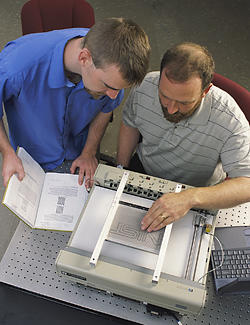
Researchers John Roberts (right) and Oliver Slattery (left) using the tactile graphic display device to depict the NIST logo.
A recently completed licensing agreement for two novel National Institute of Standards and Technology (NIST) technologies may help bring affordable graphic reading systems for the blind and visually impaired to market. The two systems bring electronic images to life in the same way that Braille makes words readable.
ELIA Life Technology Inc. of New York, N.Y., licensed for commercialization both the tactile graphic display device and fingertip graphic reader developed by NIST researchers. The former, first introduced as a prototype in 2002, allows a person to feel a succession of images on a reusable surface by raising some 3,600 small pins (actuator points) into a pattern that can be locked in place, read by touch and then reset to display the next graphic in line. Each image—from scanned illustrations, Web pages, electronic books or other sources—is sent electronically to the reader where special software determines how to create a matching tactile display. (For more information, see "NIST 'Pins' Down Imaging System for the Blind".)
An array of about 100 small, very closely spaced (1/10 of a millimeter apart) actuator points set against a user's fingertip is the key to the more recently created "tactile graphic display for localized sensory stimulation." To "view" a computer graphic with this technology, a blind or visually impaired person moves the device-tipped finger across a surface like a computer mouse to scan an image in computer memory. The computer sends a signal to the display device and moves the actuators against the skin to "translate" the pattern, replicating the sensation of the finger moving over the pattern being displayed. With further development, the technology could possibly be used to make fingertip tactile graphics practical for virtual reality systems or give a detailed sense of touch to robotic control (teleoperation) and space suit gloves.
The inspiration for both NIST graphic displays came from a "bed of nails" toy found in a novelty store. Watching the pins in the toy depress under fingers and then return to their original state started the researchers thinking about how the principle could be applied to electronic signals.
Persons interested in licensing these or other NIST technologies should contact Terry Lynch, NIST Office of Technology Partnerships, terry.lynch [at] nist.gov (terry[dot]lynch[at]nist[dot]gov), (301) 975-2691.

